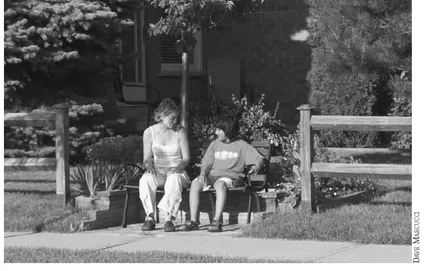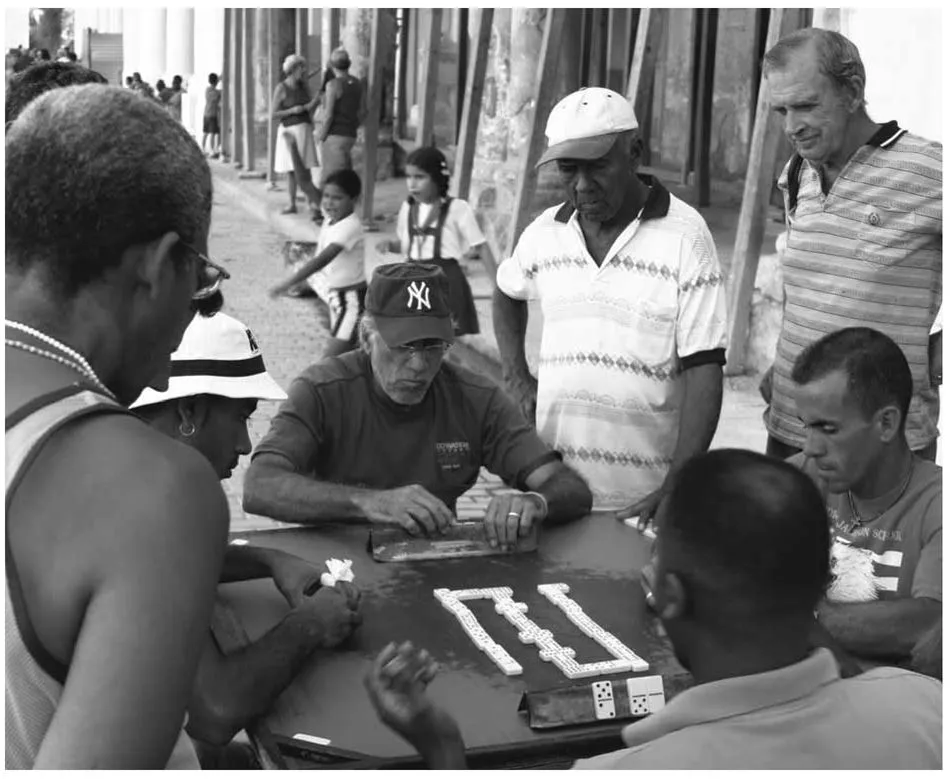![]()
dp n="24" folio="9" ?Chapter 1
Feeling Right at Home
How to foster a sense of community
dp n="25" folio="10" ?
Smile. Wave. Greet Everyone.
It’s more important than you could ever imagine
A great neighborhood is a friendly neighborhood.
It couldn’t be more simple: great neighborhoods are friendly neighborhoods. A smiling face, laughter in the air, a hearty hello can make all the difference between a good day and a dull, disappointing day. Humans evolved as social creatures, and the chance to exchange greetings with acquaintances, or even strangers, makes us feel happy and safe.
David Burwell, a long-time environmental lawyer and PPS senior associate in Washington, DC, has been tracking recent research from the field of evolutionary biology. He believes that, as a species, we are hardwired to seek convivial public settings where we can comfortably connect with one another. In fact, these kinds of places are essential to the future of the human species because they’re where boys and girls have always gone to meet one another, flirt, and, eventually, mate.
David Engwicht, an Australian activist and a leading spokesman for traffic calming, takes this idea even further. Human civilization developed, he says, from an endless series of spontaneous exchanges between people. The more opportunities there are for exchanges, he theorizes, the more rich and satisfying life is for people in that society.
Many wonder today if we’re in danger of losing these primal, civilizing instincts. The harried, isolating nature of modern life appears to be minimizing our capacity for human contact. D. Jean Hester created an art project in which she greeted everyone she met in the Central Square neighborhood of Cambridge, Massachusetts, and the results were alarming — most people responded with icy stares or nasty looks. Student journalist Mani O’Brien offers a bit more hope. She conducted a similar experiment around Tempe, Arizona, and found that she elicited positive reactions with a laid-back and cheerful “hi” but not with a cool “hello.”
So make it your mission to spread a little cheer all around. You may improve more than your neighborhood; you might help save human civilization.
RESOURCES
D. Jean Hester: “Hello” www.glowlab.com
David Engwicht: www.lesstraffic.com
dp n="26" folio="11" ? By adding a bench to his front yard, Dave Marcucci gave folks a congenial gathering spot in suburban Toronto.
The bench that built a community
Mississauga, Ontario, Canada
It doesn’t take much to start a public space renaissance in your neighborhood. In fact, as Dave Marcucci discovered, a simple bench can do the trick. After attending a PPS training course in 2005, Marcucci came away inspired by the idea that every neighborhood should have ten great places. He returned home to Mississauga, Ontario, determined to make his house, which occupies a prime corner lot, one of the great places in his neighborhood.
Marcucci started by tearing out the fence at the corner of his front yard. As he got to work landscaping the area and constructing a bench, he received a lot of quizzical comments. “Why don’t you build a bench for yourself in the backyard?” He would answer, “The bench is for you.”
When the bench was finished, Marcucci threw a street party. Soon, everyone in the neighborhood was coming by to sit on the bench. Older people stop to rest on it during their evening strolls. Kids sit there as they wait for the school bus in the morning. Families out for a walk use it to take a breather.
The complications that Marcucci first anticipated have not come to pass. The bench has not been vandalized, nor has it attracted negative uses. It was installed without approval from the city, but no one has demanded to see a permit.
“There have been no problems!” he exclaims. “It’s worked out really well. I’ve met my neighbors and other people I’d never met before. It’s added a really friendly atmosphere to the neighborhood. You sit on the bench, and as people walk by, they stop and talk to you!”
The bench is so popular that a homeowner around the corner from Marcucci has added his own bench for the whole neighborhood to use.
dp n="27" folio="12" ?
Spark a Revival of Old-Fashioned Neighborliness
How busy people can reach out to those who need a little help
In our grandparents’ time it would have been unthinkable not to take a casserole over to the family down the block coping with an illness, a death, or a colicky baby.
Nowadays that seems the stuff of fairy tales. As nice as it would be, everyone’s too busy to take on those sorts of duties. Besides, we’re not as close to our neighbors as we were in the 1940s or ’50s. One wonders what happened to the tight-knit communities we pine for when watching reruns of Leave It to Beaver or The Honeymooners. But friendly, nurturing neighborhoods didn’t just magically happen in the good old days. They were the result of conscious effort, usually carried out by women.
Even with many women working outside the home today, there’s no reason the folks on your block can’t do the kind of good deeds that turn folks-next-door into friends. People have less time now, of course, but we can compensate with e-mail, computer programs, and other efficiently modern tools. Chart out how everyone can take turns doing yard work and household errands for older people or strapped single parents. Divvy up who brings dinner to those who need it — and remember it’s quite all right to simply pick up something scrumptious at the deli.
Parents in the Kingfield neighborhood of Minneapolis maintain a babysitting co-op that lets them give each other a break from looking after the kids. For every hour they help out another family, they log an hour that they can redeem for childcare for their own kids. Such arrangements are common in many places throughout the United States and Canada.
In Hyattsville, Maryland, an electronic mailing list (listserv) has become the talk of the town thanks to a group called Hyattsville Organization for a Positive Environment (HOPE). People post messages about everything, from a lost-dog notice to well-researched critiques on development proposals for Route 1 outside town. A couple of hundred people, including public officials, closely monitor the opinions and discussions on-line, which means that things get done. A safety fence between a roaring highway and a nearby shopping area was built as a direct result of conversations on the listserv.
You could easily do the same for your town, neighborhood, or block, getting the word out on everything from a progressive dinner party to crime prevention.
Devoted fans of the old movie It’s a Wonderful Life will remember the scene in which an immigrant family moving into a new home in Bedford Falls receives a loaf of bread and bottle of wine from George Bailey. That’s another old tradition well worth reviving. Set up an ad hoc welcoming committee to formally greet your new neighbors, and fix a date after they’ve settled in to meet for coffee or drinks with the whole block. In the Bungalow Heaven neighborhood of Pasadena, California, newcomers are greeted with a packet of information on neighborhood history (including the background on their own house), happenings, and local resources.
These are the kinds of small investments that pay big dividends through the creation of a rich sense of community.
RESOURCES
Babysitting co-ops: www.todaysparent.com
Hyattsville Organization for a Positive Environment listserv: groups.yahoo.com/group/HOPE_in_Hyattsville/
A game of dominoes is part of the glue that holds a community together in Havana, Cuba.
dp n="29" folio="14" ?
Give Yourself a Break
Slow down and enjoy what’s most satisfying about your neighborhood
The greatest threat to community life is the frantic, harried, out-of-control, supersonic, unbelievably crazy pace of life that afflicts so many of us today.
You can live in the greatest neighborhood in the universe, but if you can’t take the time to stop in the cozy corner coffee shop, wander over to the farmers market on Saturday morning, or chat for a minute with your neighbor in front of the grocery store, then you might as well live on the dark side of the moon. And if too many people in your neighborhood have this same kind of busy schedule, chances are things won’t stay great for long.
The basic fact is that it takes time and energy to make a neighborhood lively. Someone must take on the responsibility to organize the street fair or make sure the local park remains safe and welcoming for kids. That’s one of the issues behind gentrification controversies in city neighborhoods and small towns. Not only do long-time residents get priced out of their homes, but the whole spirit of the place can change as concerned citizens involved in local issues are replaced by people who move there for the prestigious address or a good real estate investment rather than the community life. The wealthier newcomers often work demanding jobs, so they’ve got no energy to invest in civic projects, and they may spend their free time in exotic travel or at a vacation home rather than hanging out around the neighborhood. While per capita income in the area rises, the richness of civic life declines.
Taking the time to appreciate all that’s going on around you each day is one of the best investments you can make. Think twice about signing up for another class across town. You could learn a lot more exploring the streets around your home each evening. Trade the treadmill and stationary bicycle for a stroll or bike ride. Cancel your cable TV service and spend the savings at local diners and taverns, where you’ll get more important news, far more interesting stories, and even more opinionated sports coverage. Whole new worlds will open up, and you’ll feel more relaxed to boot.
A number of cities across Italy realized the importance a leisurely pace of life played in keeping their communities vital, so they launched a league of Slow Cities in 2000. Associated with the burgeoning Slow Food Movement, more than 100 cities (in Brazil, Norway, Sweden, Japan, Greece, Switzerland, and Great Britain as well as Italy) joined the network, united in the belief that the good life is an unhurried experience. Proudly displaying the Slow Cities logo around their towns, members pledged to:
• Restrain racing traffic by limiting automobiles and promoting sustainable transportation alternatives such as bikes and pedestrian zones.
• Encourage businesses, schools, and government to improve the quality of...




